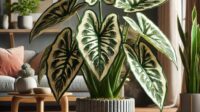
Well, if you want a plant that can get anyone’s attention right then Alocasia Zebrina is the one. Not only do the large, arrow-shaped leaves of this tropical plant have bright white veins that contrast beautifully against purple-green foliage, but they also come perched on zebra-pattered stems that make them an excellent choice for any indoor garden. The Alocasia Zebrina is a plant with visual allure, that brings to your space an exotic supple sophistication. In this article, we will discuss an outstanding plant — Alocasia Zebrina: its specific features and care guidelines thus provide it with a well-deserved place in the collection of any gardener. Whether you are an experienced gardener or new to the garden, this is a comprehensive guide for keeping Alocasia Zebrina happy and well.
1. Overview of Alocasia Zebrina
Alocasia Zebrina is an Araceae, which comes from the hot terrain of Southeast Asia. The lush foliage of this plant with its dramatic leaves and interesting stems give a tropical feel that can add style to any indoor environment.
2. Alocasia Zebrina Unique Traits
Beautiful Leaf Shape:Large, arrow shaped leaves that can grow quite large giving this plant some dramatic presence.
Zebra Like Stems: The stems have a unique zebra pattern similar to that found on the stripes of an actual Zebra and this makes it beautiful when you see them.
Tropical Foliage: this plant stands out due to its odd leaf shape and stem pattern, which makes it look particularly exotic.
3. Why Alocasia Zebrina for Your Indoor Garden?
Aesthetic Investment The striking presence of the BRABBU portfolio a synonym with luxury furniture offering an extra slug for your room.
Low Maintenance: If they are cared for properly, Alocasia Zebrinas can flourish indoors which makes it ideal even if you do not have a green thumb!
Air Purification: Alocasia Zebrina, like other houseplants can purify indoor air by filtering toxins.
4. Optimal Alocasia Zebrina Growing Conditions
Light: Needs, prefers bright light indirectly but can adapt to some direct sunlight.
Temperature and Humidity: Likes temperatures between 65°F to 85°F (18°C to 29°) but can do well with some cooler/enduring better in warmer temps. High humidity is preferred_everyone benefits from more humid conditions
5. Watering Guidelines
Watering Once the top 1 inch of soil is dry.
Winter Care: Scale back on watering in winter when the plant is dormant.
Drainage make sure your pots are well draining to avoid root rot.
6. Soil Preferences
Good-Draining: Alocasia Zebrina needs a good-drained potting mixture
Suggested Mix: A peat, perlite and orchid bark mixture helps retain moisture without becoming water-logged.
7. Fertilization Practices
Feeding Schedule: Apply a balanced liquid fertilizer every 4-6 weeks during the growing season.
No Fertilizing In Winter: The plant goes dormant in winter so give it a little rest during the cold monthsantlrqts.
8. Pruning and Maintenance
Regular Pruning zoning up yellowing dead leafs to make way for infant leaves) Pinch off new growth at the end.
Cleaning the Leaves: In order to protect its natural glow, pedalling dust from water-moistened leaves.
9. Common Pests and Diseases
Pests: Spider mites, mealybugs, and aphids can be problems; use neem oil or insecticidal soap to get rid of any infestations.
Diseases: Prevent root rot by providing ample drainage and appropriate irrigation.
10. Propagation Techniques
How To Propagate Alocasia Zebrina- Method Of Propagation-Ideally, Division during repotting is the most effective way to propagate an alocasia zebrina.
Planting Divisions: Divide with roots in tact and replant divisions into fresh soil.
11. How To Style An Alocasia Zebrina In Your Home
Recommended focal point: Use Alocasia Zebrina in living rooms or whimsical entryways and foyer
Decorative Pots Go for attractive pots that complement the boldness of the plant.
Plant Buddies: Rotate with other tropical plants for the ultimate indoors-forest vibe
12. Advantages of Growing Alocasia Zebrina in doors
Appearance: Ideal for the styling of interiors with a tropical sense and sophistication.
Stress Relief Indoor plants help in providing a calm environment which can be useful for relieving stress.
Goes With Everything: Easy to incorporate into different decor styles, from contemporary to boho.
13. Frequently Asked Questions
FAQs- Can dogs eat aioli-Frequently Asked Questions: Is Alocasia Zebrina safe for pets? A: Yes, as with most Alocasia plants they are toxic to pets if ingested so keep them out of paws reach!
How frequently do I repot my Alocasia? Circa: Every 1-2 years, or as it becomes root-bound.
How can I get Alocasia to grow? : Make sure your light, humidity and watering conditions are on point.
14. Where to Buy Alocasia Zebrina
You can look in a local nursery
Online Retailers: There are websites like Amazon, Etsy and specialty plant shops that sells Alocasia Zebrina.
Plant Exchanges Other than the common varieties, you can connect with local plant exchange groups which helps in finding unusual plants.
15. Conclusion
The Alocasia Zebrina is a stunning and dramatic option for any indoor garden. But what that makes for a great houseplant and favorite of plant collectors, is its unique properties as wella s relatively easy care needs. So, there you have it my step by step guide to properly grow and care for the Alocasia Zebrina so that your plant is happy and alive them living happily ever after in your home. Do you want to add this stunning plant your collection?






